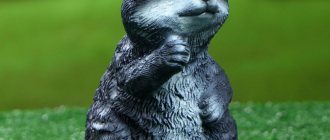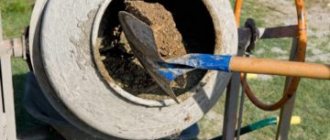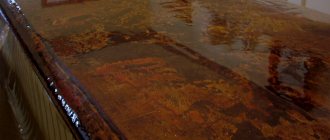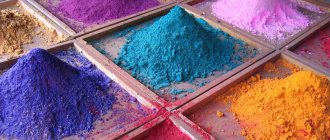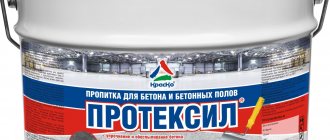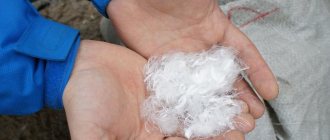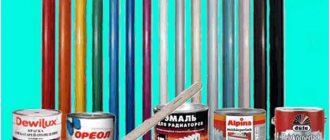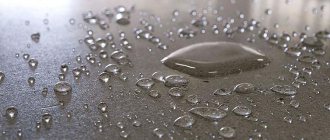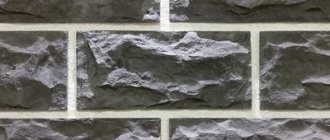Garden flowerpots are large-sized products in which flowers and beautiful ornamental plants are grown. They can be produced in rectangular, round, trapezoidal, square, hexagonal and even unusual shapes. Their design often impresses with exclusivity and elegance. After all, flower beds are used to decorate parks, squares, alleys, recreation areas, private areas, entrances to commercial, retail, public and other buildings. You can create multi-level compositions from flowerpots.
Is it possible to paint a concrete surface?
If it is necessary to paint a concrete floor in order to provide a color solution, paints for concrete floors, concrete floors, as well as polymer self-leveling floors are used: epoxy self-leveling floor or polyurethane self-leveling floor. ... Therefore, putty and paint form a monolithic coating.
Interesting materials:
How to make a heart-shaped coffee tree with your own hands? How to make a jacket softer? How to make a footer like in the previous section? How to make a footer only on certain pages? How to make a footer only from the second page? How to make headers and footers from page 3? How to make a command run in Windows 7? How to make feed for quails at home? How to make a teenager's room cozy? How to make a room with dark wallpaper lighter?
Types of concrete paints that are suitable for interior and exterior work
Concrete paint is selected based on several criteria. The most important is where the work is carried out - outside or inside the premises. For outdoor work, it is important that the material is resistant to low temperatures and UV rays, moisture resistant, dries quickly and looks aesthetically pleasing.
Indoor paint must be safe for health and not contain highly toxic components. For both indoor and outdoor work, the paint should protect the concrete from moisture.
Basic requirements for paint, regardless of where it is used:
- good adhesion,
- vapor permeability,
- abrasion resistance,
- economical consumption.
Classification by composition and type of surface to be painted
To get the desired result, experts recommend paying great attention to choosing the right paint for concrete. There is a lot of different information on the Internet, but there is a standard gradation of materials according to composition and type of surface to be painted.
You can list the main materials by composition:
- Acrylic. These paints are popular not only for concrete surfaces. They contain special polymers and their derivatives, under the influence of which a dense, elastic, breathable film is obtained. Among the advantages of acrylic paints, it is worth noting wear resistance, economical consumption, low price, good hiding power, ease of application, durability of the coating, high drying speed and the ability to use in moderately damp rooms.
- Among the disadvantages, they note the need for careful preparation of the surface for painting, including preliminary priming.
- It is important not to confuse acrylic and alkyd enamels. Alkyd paints are oil paints. They form a hard film on the surface, whose performance properties are worse than those of acrylic compounds.
- Epoxy. They contain epoxy resin and hardener, which must be mixed with a construction mixer to obtain finished enamel. The result is that a waterproof, durable film hardens on the concrete base, which is resistant to any type of impact and retains its appearance for a long time. Therefore, it is often purchased for painting concrete floors. Depending on additional components, the film can be flexible or rigid.
- Among the disadvantages is the possibility of an error in proportions during preparation of the composition.
- Vinyl. These paints create a beautiful matte surface, dry quickly, cover well in one coat, are odorless, environmentally friendly and hypoallergenic. However, now they have almost been replaced by acrylic analogues, since the service life of vinyl coating is no more than 7 years, it is not moisture resistant enough and almost does not “breathe”, which means that concrete deteriorates faster.
- Polyurethane. This is an ideal paint for concrete floors. Particularly resistant to abrasion and mechanical stress. The only negative is the long drying time; complete drying takes up to two weeks.
- Rubber. The consistency is similar to mastic, which after drying resembles rubber. The coating is very durable, but at the same time elastic due to the acrylate latex in the composition. One of the advantages is frost resistance: you can work with paint outside even at -50 degrees. Latex paints are often used on playgrounds and sports fields.
- Water-based. The main component of paint is water, so such materials are non-toxic, easy to wash off, do not smell and are available in a wide palette of shades.
- Silicone emulsion. One of the best offers in terms of its characteristics on the market. It can be used within two days after the concrete has hardened. The enamel forms a completely waterproof, but at the same time “breathable” coating, has high adhesion, is elastic, and wear-resistant. The only drawback is the very high price.
Depending on the surface that is supposed to be painted, there are:
- Concrete enamel for facade. Concrete walls of buildings must be protected from aggressive environmental influences. What is important here is the high penetrating ability of the composition and economical consumption, as well as service life, since repainting building facades is not a very fast and labor-intensive process.
- Foundation paints. Acrylic, polyurethane, epoxy, and silicone compounds are suitable here. When choosing, you need to be guided by the characteristics of concrete and environmental factors. For example, for cold regions, paints based on epoxy resins are used.
- Floor paints. Paints for concrete floors must meet several criteria - resistance to abrasion and mechanical damage, as well as moisture resistance. Polyurethane, acrylic, rubber, epoxy enamels have these properties.
- Materials for painting paving slabs, concrete garden paths and blind areas. The same requirements apply to these paints as to floor paints. But additional attention is paid to protection from precipitation, so acrylic compounds are not suitable here.
How are colorful flowerpots created?
Concrete is painted both at the stage of its production (for example, while mixing cement with water), and after it sets and hardens. According to experts, it is best to give flowerpots the desired shade during their production:
- Even if the top layer is erased, the color of the vessels will not change. After all, during the production of the material, it is completely colored.
- To create a mixture of the desired color, special powder dyes, called pigments, are added to it. These components color the water and give the cement its brightness. Pigments can be mineral or organic.
- As a rule, powders after drying are not washed out by rain and are characterized by increased resistance to exposure to sunlight. That’s why garden flowerpots made of concrete will retain a presentable appearance for many years.
- Unfortunately, this method of coloring the material is not popular among manufacturers of decorative vases. After all, when high-quality pigments are added to raw materials, the price of the finished product increases.
- As practice shows, in 90-95% of cases, craftsmen decorate ready-made flowerpots, covering their surfaces with various substances.
How to make a flowerbed from cement with your own hands
To successfully make concrete flower beds with your own hands, you need to adhere to the proportions when preparing the working solution, and correctly build the frame and pour it.
Layout
Before you make a concrete flowerbed with your own hands, you need to think carefully about where it will be placed. To install an original flower bed with perennial plants, it is recommended to choose places at the entrance to the plot, in the garden, near paths.
Multi-tiered concrete structures can effectively decorate any area
Planning involves choosing a site, designing a flower garden, and selecting plants. The flowerbed should have a presentable appearance from spring to late autumn. To make it easier to navigate when making a concrete structure, it is recommended to make a sketch on a sheet of paper, which will include the dimensions of the flowerbed, the configuration, and the number of plants.
Tools
To make concrete flower beds with your own hands, you will need a set consisting of the following materials and tools:
- cement;
- fine crushed stone;
- sand;
- plasticizers;
- coloring pigment;
- polyethylene;
- high density cardboard;
- lumber for collecting formwork;
- scotch;
- shovel;
- scissors.
To make outdoor flower beds from concrete, it is worth adding water-repellent and frost-resistant additives to the solution to extend their service life.
Portland cement, which contains slag, clinker, ash, pozzolans and other mineral particles, is ideal as a binder for flower beds. You can also use expanded clay concrete, sand concrete, consisting of sand of different fractions. Water for the solution can be ground water, drinking water, or for technical purposes.
Land works
The next step after planning and preparing the necessary materials and tools will be to transfer the contours of the concrete structure to the ground surface. The first step is to mark the area along the outside of the future flower bed, and then along the inside, making an indentation of 20 cm. In order for the flower garden to be sufficiently stable, the wall thickness is needed from 15 cm. The depth of the trench should be 15 cm, and it should be well compacted on the sides .
The width of the trench should correspond to the thickness of the walls of the concrete flower bed
Frame
To make the frame, you will need fragments from a sheet of chipboard or fiberboard. According to the contour of the future structure, pegs 30 cm long are installed from cement. It is recommended to secure them with screws to the formwork for reliability. For wavy flower beds, plastic is more suitable; it is easier to work with. To fix the frame, you need to provide spacers on the outside.
The contours of the installed formwork must exactly follow the outlines of the future flower garden
Fill
To obtain high-quality cement mortar, it is necessary to strictly observe the proportions of the components used. The concrete mass is prepared from:
- sand (4 parts);
- cement (1 part);
- fine crushed stone (4 parts);
- water (the solution should have a creamy consistency).
Upon completion of pouring, the concrete must be leveled for greater aesthetics.
The optimal air temperature for pouring work is from -5 °C. If there is high humidity outside, then it is better to abandon plans and postpone them to another, more favorable day. If the weather is hot, the soil must be moistened before pouring concrete. Otherwise, the moisture from the working solution will simply go into the dry soil.
The concrete solution must be poured carefully and evenly. The frame should only be removed when the concrete is completely dry. At the end of the work, the flower garden is filled with fertile soil and decorated with ornamental crops.
Tools and materials
Working equipment for the classic painting procedure:
- roller or spray bottle;
- paint brushes, scrapers, sanding material;
- bath for dye.
The high-quality painting procedure requires the use of the following products:
- dye selected for the intended use;
- high-quality degreaser for concrete surfaces;
- primer to improve adhesion;
- sealant.
If the process of painting concrete is carried out near flower beds or a garden, you need to purchase plastic film to cover the green area. This manipulation will protect the vegetation from contact with the chemicals used.
Acrylic paints
Acrylic paint has very good adhesion to the base, elasticity, resistance to dirt and water washing. It boasts low permeability, is suitable for restoring an old façade, it can also be used to paint mineral substrates, and to lay it on previously painted layers of cement and cement-lime plaster. It should not be used on silicate or lime plastered surfaces.
Acrylic paint consumption - 110-135 g/m².
Acrylic facade paints
Paints based on acrylate and vinyl, as well as those based on silicone resins, can be either water-soluble or solvent-soluble
Technology
Painting an object involves performing mandatory and additional actions. The first is preparation of the base and finishing. The second includes dismantling, removing debris, working to protect adjacent structures from dust and contamination, limiting the work area with waterproof materials (adhesive tapes, tapes, films, stencils). Let's look at how to properly paint a concrete wall, floor, ceiling or exterior structure.
Preparing the base
Before painting concrete, it must be properly prepared. The base must be dry, clean, free of grease stains and free from rust or fungal growths. Since paintwork materials create a thin film, they are practically unable to fill pores and cracks. That is, you additionally need to remove dust from the surface and fill in all defects.
Upon closer examination, the following materials and means are used to solve the assigned problems (examples):
- cleaning of old paint - compositions with a high alkali content;
Mechanical removal of old coating Source yandex.net
- degreasing – 500 grams of soda ash with the addition of 10 liters of water;
- rust removal - removal with water and prevention with a solution of copper sulfate (15%);
- elimination of mold - impregnation with a destroyer followed by mechanical removal, washing with clean water, preventive treatment with a protective antiseptic for concrete (mineral surface);
- dust removal (before each stage of concrete preparation) - deep penetration primer, applied in at least 2 layers with intermediate drying.
To fill pores and cracks, plaster and putty are used, which are intended for working with mineral bases. If the surface is uniform and without defects, then you can immediately begin sanding. This will ensure smoothing, which will have a positive effect on the aesthetics of the paint coating. The grain size of the abrasive cloth can be equal to 80-100 units.
Sheets of sandpaper Source cloudinary.com
Coloring
Work is performed only on monoliths more than 30 days old after pouring. An exception is the use of dry pigment to tint a freshly poured walkway. Optimal conditions are considered to be temperatures above +10 degrees Celsius and relative air humidity in the range of 60-75%.
Concrete has low absorbency. Therefore, the application of the coloring composition must be impregnating in nature. The best way to solve the problem is with a roller. For the spray gun you need to use watery compounds. Spray the paint in 2-3 passes in a thin layer with intermediate drying within 12 hours.
Painting with a brush is also acceptable. Here you need to be prepared for the appearance of furrows from stubble. This is justified by the use of viscous paints. To visually smooth out the coating, you can paint the surface in 2-3 layers.
Stages of work: how to organize painting?
Removing contaminants
Before carrying out the procedure, it is necessary to remove dirt and elements of the old coating.
To prepare a concrete surface for the painting procedure, it must be cleaned of such contaminants as:
- dust accumulations;
- grease stains (from gasoline, automobile oil, traces of gases contained in the air);
- lime and chalk;
- pollution and garbage;
- peeling elements of the old paintwork.
If a concrete structure has previously been painted with alkyd or oil-based compounds, it must be completely cleared of coloring matter, since dyes do not interact with other paints. Fill holes and cracks with putty.
Primer and degreaser: why are they needed?
Before using the primer, the surface is degreased. The final step before painting concrete is primer. Applying primer to a concrete surface will provide a number of advantages:
- will reduce the consumption of coloring material;
- remove dust from the surface;
- will level the surface, which will facilitate the painting process;
- protects against the occurrence of fungus and mold;
- will increase adhesion between building elements.
Difficulties
There are several types of omissions that most often occur when painting a concrete plinth:
- painting wet concrete;
- applying paint to the surface without prior preparation;
- using primer and paint from different manufacturers and different compositions;
- painting is done in one layer;
- When applying several layers there is not enough time for them to dry.
Any type of error will lead to a decrease in the quality of painting and the service life of the coating.
Is it possible to paint aerated concrete blocks without plaster?
Aerated block is a building material that requires mandatory finishing. This is due to the high hygroscopicity of cellular concrete. Therefore, finishing for aerated block walls must meet three basic requirements:
- prevent street moisture from penetrating into the concrete structure;
- provide the necessary vapor permeability so that the walls “breathe”;
- ensure normal operation of the building.
Facade plaster fully meets these requirements. Aerated concrete paint for exterior use is applied on top of the plaster layer, which gives the wall the desired color and texture. Is it possible to paint aerated concrete without plaster? It is possible if the selected paint for aerated concrete meets the specified requirements, that is, it forms a vapor-permeable, moisture-resistant layer on the surface. Not all paints and varnishes have such properties. So how to paint aerated concrete blocks on the outside without plaster, and what paint should you use to plaster the walls? Let's look at different types of paints in more detail.
Safety precautions
As when performing any work, simple safety rules should be followed. The coating must be done in special clothing, protecting your hands and face from paint, acids and other solutions.
You also need to remember a few simple tips:
- Use a respirator when removing old paint. In the past, lead-containing paints were often used; their dust is harmful to health.
- Collect waste during processing in a closed container.
- For work, use a mixture with a valid expiration date.
- Store the remaining paint after finishing the work tightly closed in a room with a temperature not lower than +12°C.
- If paint gets on your skin, be sure to wash it off with a cotton pad soaked in solvent or sunflower oil.
Also learn about how to make concrete products for landscaping.
